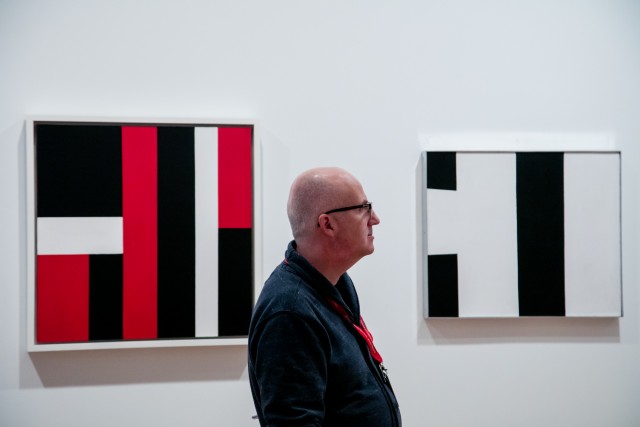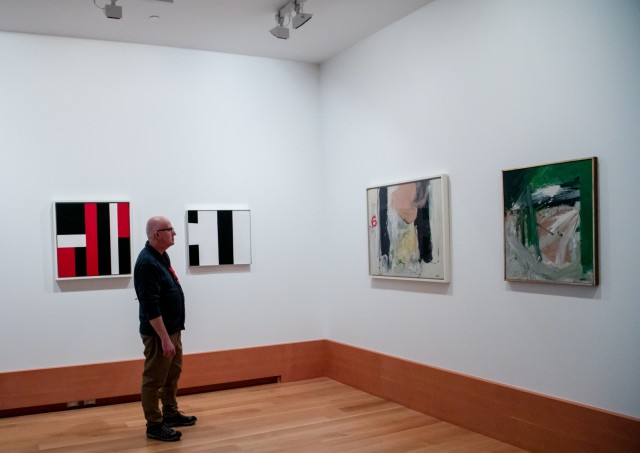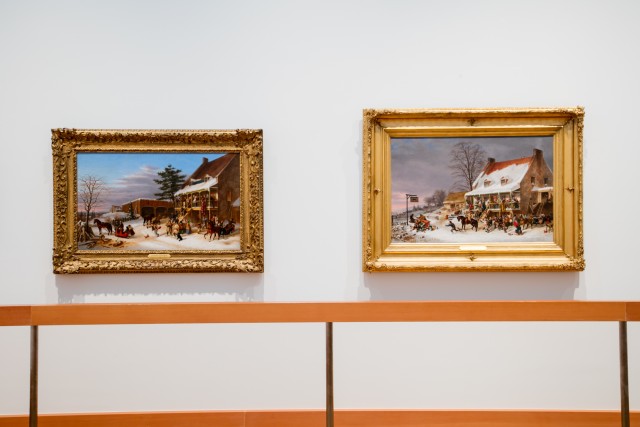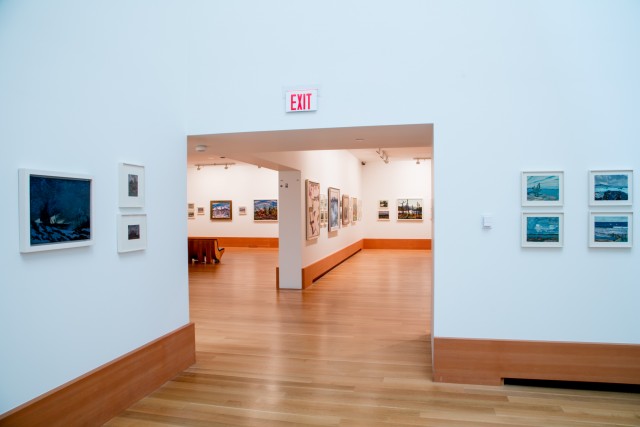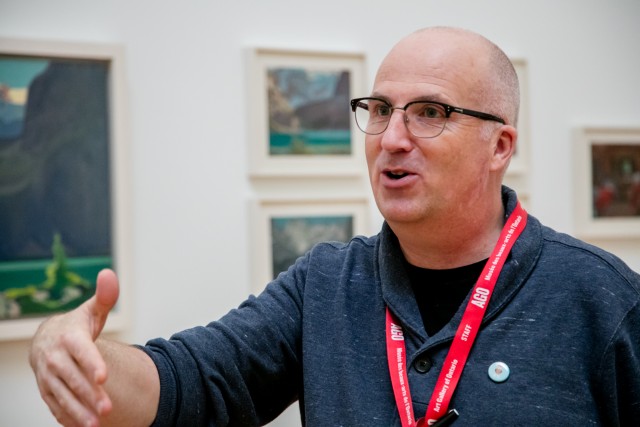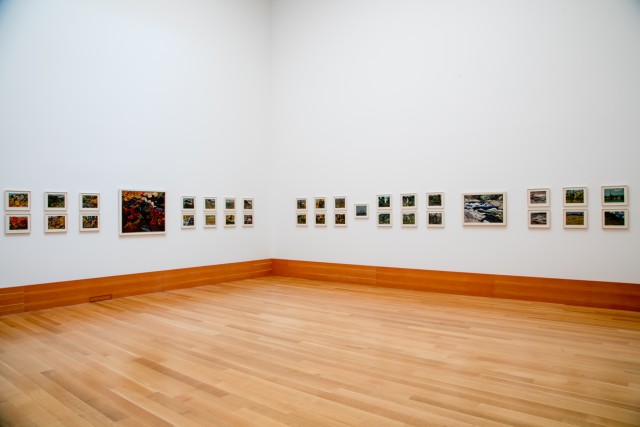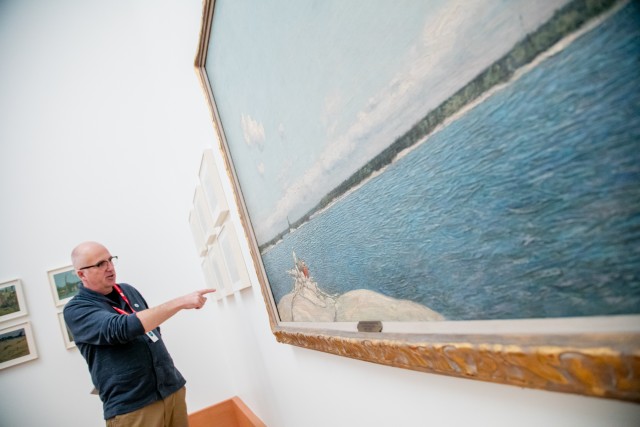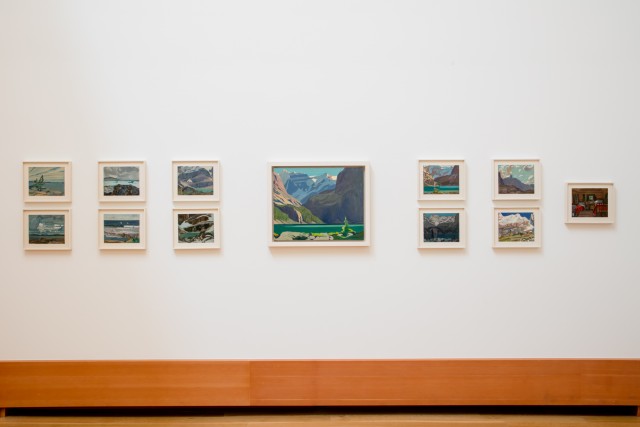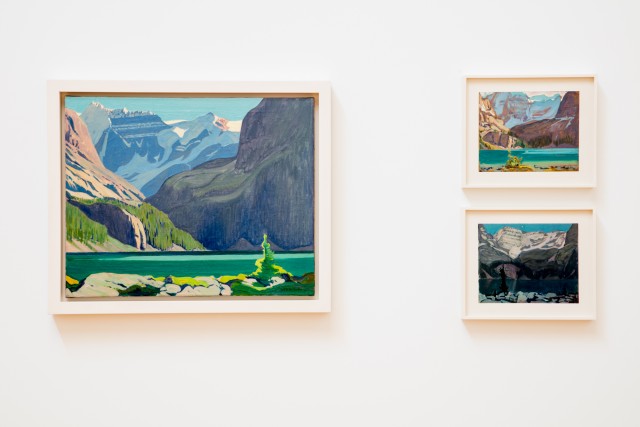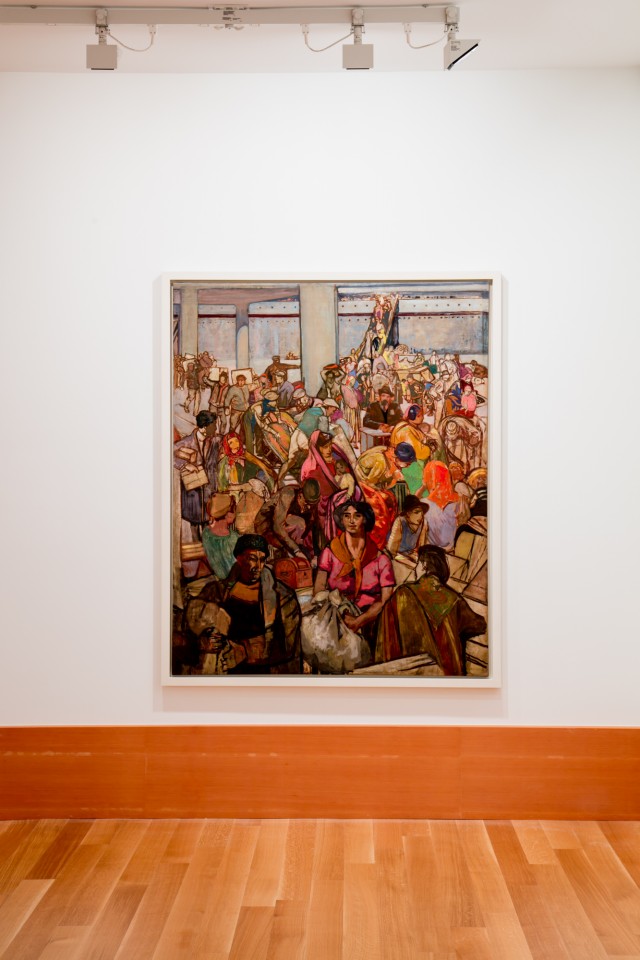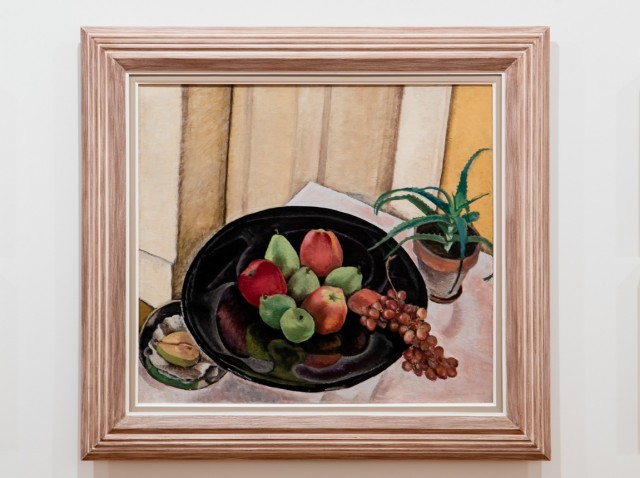Need plans for the Canada Day long weekend? We’re open!
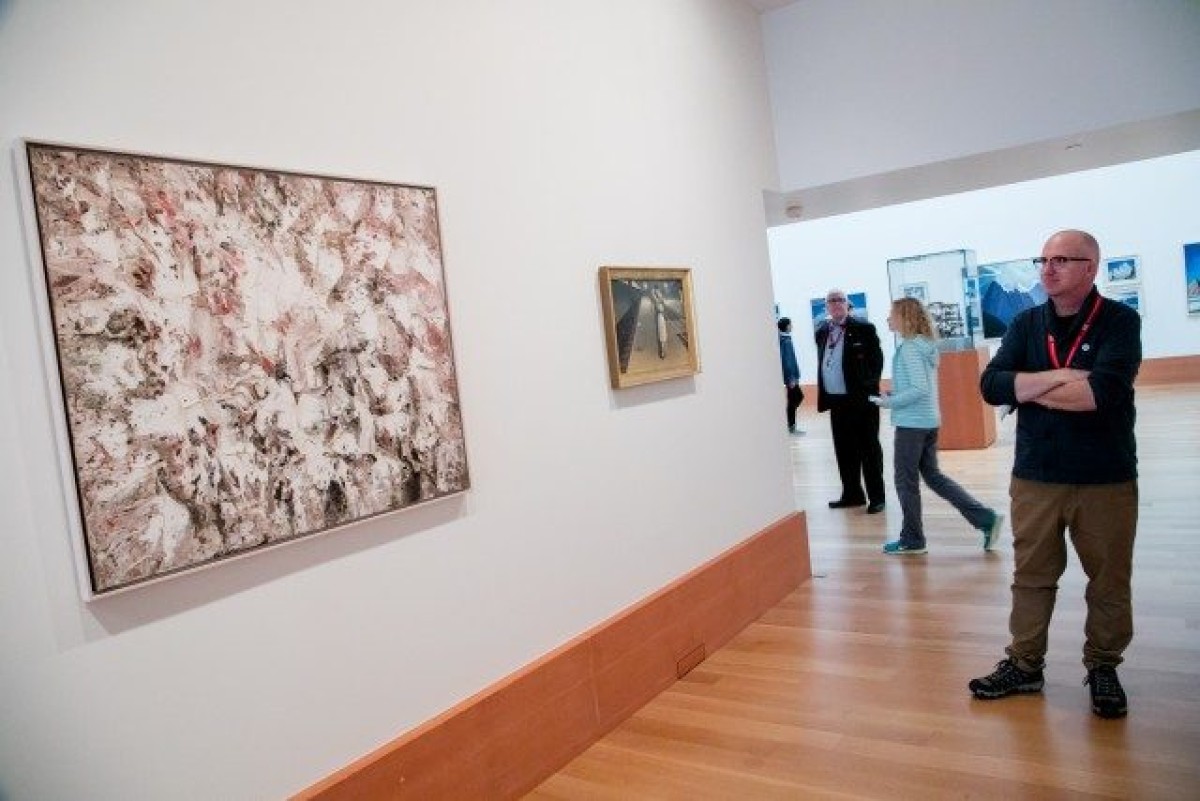
Curator Andrew Hunter with (left) Paul Emile Borduas, Beating of Wings at Bonaventure, 1954, oil on canvas, 96.5 x 118.9 cm, The Thomson Collection © Art Gallery of Ontario. (right) Alex Colville, Soldier and Girl at Station, 1953, glazed tempera on board, 40.6 x 61 cm, The Thomson Collection © Art Gallery of Ontario.
Happy Canada Day! There’s no shortage of activities in Toronto this long weekend. This happens to be a particularly special year for Canada’s birthday (not sure if you’ve heard…)
But if you’re tired of the same old fireworks, think outdoor concerts are too much trouble, or if you’re looking for some Canadian artistic inspiration this holiday weekend, look to the AGO as your go-to destination. We’re open the following hours over Canada Day weekend:
Friday, June 30 – 10:30 am – 9 pm
Saturday, July 1 – 10:30 am – 4 pm
Sunday, July 2 – 10:30 am – 5:30 pm
Monday, July 3 – 10:30 am – 4 pm
The AGO is the best place to see iconic pieces of Canadian art (and some soon-to-be-iconic artwork in our upcoming exhibition, Every. Now. Then: Reframing Nationhood, opening June 29). But don’t take our word for it; let curator Andrew Hunter offer some thoughts on the AGO’s beloved Thomson Collection of Canadian Art, located on Level 2, just in front of the staircase. We made some changes to the galleries in 2016, the first time the collection was reinstalled since 2008. And just in case you didn’t realize: it’s more than just the Group of Seven!
Post-war rooms
“This is going to be a surprise for people. Beginning with Cornelius Krieghoff (1815–1872), the Thomson Collection of Canadian Art tells the story of how the medium of painting progressed in this country. With the new inclusion of works from the 1950s and ‘60s, we’re adding an entirely new chapter. Strong, post-war Québécois painting is a vital part of our history.”
“Guido Molinari was a clear standout in Quebec during his own time. Krieghoff’s work offers a way of imagining Lower Canada/Quebec in mid-19th century, and 100 years later we have these Molinari works that clear away the old thinking and hit the reset button with his modern vision. So these are bold, modern paintings and also quite strong political statements.”
“Charles Gagnon’s works are also representative of the explosion of abstraction after the war, but done with a very different approach—his work has an expressive, painterly approach. Molinari’s is precise, analytical. I love these works in conversation—it’s a nice contrast.”
Post-war rooms (continued)
“Another nice surprise is seeing Alex Colville’s work from the 1950s alongside Paul-Émile Borduas in the 1950s—you can see how the two artists are in completely different worlds. Their styles speak to the emergence in Canada of a strong, international approach, and this pairing says something very particular about Colville. When he emerged in the ’50s, he was making this type of work, and this room illustrates what it was like for him on the scene. Borduas’ works show where the broader momentum in art was going, but there were artists like Colville who stuck to their guns. We wanted to highlight these crucial moments in the Thomson Collection of Canadian Art, because it’s exciting to contemplate these slightly rogue, individual artists.”
Cornelius Krieghoff rooms
“Another one of our goals was to refine our display of Cornelius Krieghoff works. Here we’ve placed Krieghoff alongside a number of artists who, in the 19th century, were representing the interaction between settler culture and Indigenous peoples. What you see here is Verner and Berczy in dialogue with Krieghoff. In the corner we have the three main Indigenous cultures of this region (Anishinaabe, Haudenosaunee and Wyandot) all brought together, offering an opportunity to talk about some of the important social history all these artists were trying to represent.”
“We refined this room to showcase the many threads running through Krieghoff’s work by grouping paintings that share many of the same characters, motifs, stories and compositions. In this series, you see Krieghoff expressing the full diversity of Lower Canada coming together, his observations of class and society, and his attention to detail in illustrating those populations.”
“Krieghoff was a businessman, and he made a living through his painting. What you see on these walls are the various scales of the paintings he made for his patrons, and how they were indicative of the market: some collectors could only afford or want small works, so that’s what Krieghoff would create. Regardless of scale, the quality was always high.”
The Group of Seven: A new view
“The walls have come down. You can stand in the centre of these rooms, turn around, and see Tom Thomson and J.E.H. MacDonald side by side, which is important because the two artists were so connected early on in their careers. Now the rooms themselves are so much airier, larger, with fantastic lighting, achieving our goal to open up the spaces. You stand here and get a 360 view of the Group of Seven rooms.”
J.E.H. MacDonald
“In the previous installation, J.E.H MacDonald’s works were spread throughout various galleries. He was well represented, but there wasn’t a concentration of it that visitors could experience in one room. Now you can see the full sweep of his career; following the walls counter-clockwise, you see his early works from Toronto, his moves further into the wilderness, the North, and, in the last sequence, the West.”
“MacDonald’s paintings of the Rockies are quite spectacular, and are very different from Lawren Harris’s views of the Rockies, two rooms away. With Harris, you get this grander, at-a-distance view of mountains that fill the frame like big icons. Meanwhile MacDonald is absolutely in them, painting at the base, and you get the sense that these mountains are so big it would be impossible to even fit them in the frame.”
Frederick Varley’s Immigrants
“This is a big, bold painting that’s quite surprising to people. It’s not quite what they expect to see when they visit the Group of Seven galleries, but it’s important to remember that Varley was largely a portrait and a war artist who often represented social issues in his work. It’s also a nice reminder and celebration, at this particular moment, of newcomers to Canada. It’s not a new idea, and it’s really powerfully rendered by Varley. And it’s grounded in the middle by this spectacular portrait of the woman in the pink, who’s moving forward towards us.”
Paraskeva Clark’s Still Life with Apples and Grapes
“Many people don’t realize that when the Group of Seven had their shows in Toronto, they often invited other artists to show with them. Artists from Montreal, like Edwin Holgate (who became a member of the Group of Seven), the Beaver Hall Group, and Toronto artist Paraskeva Clark. This work, which was a really important piece for Ken Thomson in his collection, reminds us of the artists who were in dialogue with the Group of Seven, and where the Group was going.”
“Many people don’t realize that when the Group of Seven had their shows in Toronto, they often invited other artists to show with them. Artists from Montreal, like Edwin Holgate (who became a member of the Group of Seven), the Beaver Hall Group, and Toronto artist Paraskeva Clark. This work, which was a really important piece for Ken Thomson in his collection, reminds us of the artists who were in dialogue with the Group of Seven, and where the Group was going.”


